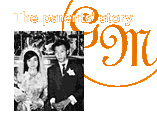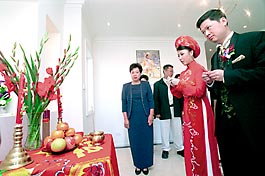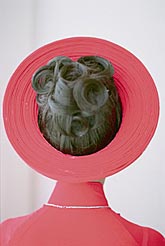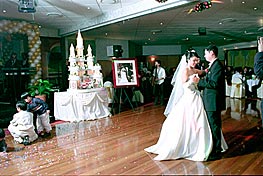
Rachel & Neill |
Michelle & VinhAuthor: Mary Ann Hamilton, Getting Married project
Getting Married: Michelle Nguyen and Vinh Luc married in 2002 with traditional Buddhist prayers and celebrations. Their wedding rituals and feast, celebrating the couple's Vietnamese and Chinese heritage, took almost the whole of one spring Saturday. The day was long but joyous, a celebration of their commitment to each other within their families and wider community.
Marrying in the Buddhist tradition One Saturday morning People crowd into the front garden of the Nguyen's home in Canley Vale. Everyone is dressed up and a number of the young women, Michelle's bridesmaids, wear ao dai, the traditional Vietnamese ‘long dress'. The ao dai are intricately handpainted in pastel shades, and from a distance the girls look like a moving painting. The noise of the crackers continues for the next five minutes. Children scream and jump with excitement and the bridesmaids grin and clamp their hands over their ears while they wait for the groom to arrive at Michelle's parents' house. The groom arrives “Gifts of food wine and jewellery are brought for the bride and her family. The dragon and phoenix represent the bride and groom and the Chinese script characters song hy mean together – so the figures and the words celebrate the marriage of the couple.” (Informant at wedding) The bridesmaids line up opposite the men who then, one by one, step forward and offer their gifts. Mrs Nguyen stands at the head of the lines and gives each of the men a small red envelope containing some money.
At the bride's home – permission to marry Michelle and Vinh light incense and offer prayers at the family's altar. They ask permission from their ancestors to be married and for blessings for their future family. Vinh and Michelle rise and bow to Mr and Mrs Nguyen in a gesture of thanks for their parental care of Michelle. Michelle's parents bow in return and Mr Nguyen addresses the couple, declaring, “We are handing our daughter to you, Vinh.” Although he speaks in Vietnamese his feelings are clear to all – happiness for his daughter's happiness but sorrow for her loss to the family. Mr Nguyen then pours tea for the couple, first into one large bowl then into one cup for Vinh and one for Michelle. They drink the tea as they are watched closely by their family and friends. The offer and acceptance of tea is a very important ritual in Vietnamese culture. It denotes the commencement of important interactions and events. The tea is prepared specially by the host, and to refuse tea is considered an affront. The conduct of a tea ceremony at the wedding ritually signals that Michelle's parents have given their blessing to Vinh and Michelle's marriage. At the couple's home – a marriage completed The front door of their house is decorated with red banners embossed with gold characters – these announce the house as that of a couple of newlyweds. Inside, Michelle's shrine to Quan Yin, the Buddhist Goddess of Compassion, has been laid out with offerings of red gladioli, the Vietnamese traditional flower of celebration, and fresh fruit. The couple light incense and are joined by Vinh's mother. All three bow their heads and pray for their marriage to be blessed. Again, this important occasion is formally celebrated with tea, as Vinh and Michelle offer a cup to Vinh's mother. Vinh's mother then sits and dresses Michelle in the gifts of jewellery she has brought; a necklace, bangle and earrings. The couple exchange gold rings. Tea is offered to Michelle's parents and then to all the aunts and uncles, who in turn offer li xi or lai see to the couple in the traditional small red envelopes. The couple are now married in the eyes of their family and the community. Civil marriage
White wedding photos
She and Vinh leave for the nearby park for an afternoon posing for wedding photographs. Getting together Meeting The decision to marry came as a natural extension of their deepening relationship, although Michelle was very aware that in the eyes of her parents she needed to settle down and get married.
Vinh and Michelle's engagement
While they both feel it is a huge responsibility that they are undertaking, they trust that with good communication and a shared commitment to work through difficulties, they will nurture a strong and lasting relationship. Vietnam and Australia Vinh and Michelle share the experience of growing up in a migrant family in suburban Sydney and they also share their faith. They are both practicing Buddhists and the wedding ceremony follows the Buddhist tradition.
A cross-cultural marriage
At one stage during the preparations for the wedding, Vinh and Michelle were worried that Vinh's mother may not accept the arrangements for the second round of ceremonies. Traditionally these would take place at the groom's parents' home, but Vinh and Michelle's new home was planned as the venue. Additionally, in the Chinese Buddhist tradition the groom's parents do not go to the bride's home. The groom is attended only by his uncles and brothers. When they meet with the bride's father, they negotiate a bride price which has to be agreed before the marriage goes ahead. Similarly the bride's parents would not attend the ceremonies at the groom's house. Vinh and Micelle have attempted to accommodate both traditions. In accordance with the Chinese tradition Vinh's mother greeted the couple in their new home, although strictly speaking this would happen at Vinh's mother's home. Other traditions are shared between the Chinese and Vietnamese culture. The exchange of gold rings is observed in both cultures' wedding ceremonies as is the use of the color red, the traditional colour of happiness and wealth. Red gladioli decorate the houses and shrines, the bride's dress is red, there is red writing on Chinese wedding cakes, and before the couple's first night together the mothers make up their bed with new red sheets. The reception - a party for hundreds A big reception
At 8pm Michelle and Vinh arrive at the Crystal Palace Reception Centre at Cabramatta in southwest Sydney. The room is filled with the 400 odd invited guests. Traditionally, wedding invitations are delivered by hand. While some of Michelle's younger friends accepted invitations by post, all her parents' friends were handed their invitation in person. As each guest enters they hand those greeting them li xi, intended for the bride and groom. Traditionally the li xi would be given directly to the couple as they make their way to each table to share a toast to their future. The money will help cover the cost of the ten course dinner they are to enjoy. They sign the large red cloth at the reception, which Michelle and Vinh will keep as a memento of their wedding day, and take their seats. More work for the newlyweds About half way through the evening, after the meal and thank you speeches, the house lights are dimmed, bathing the stage in patches of pastel and violet light. The wedding cake, a huge palace-shaped confection inhabited by tiny Disney characters, is brought out. The couple dance a bridal waltz, the cake is cut, and the floor is thrown open for the guests to dance and, on occasion, to lead the singing of popular Vietnamese songs. The show is stolen by one small relative of Michelle's who displays amazing confidence singing in front of the many guests assembled. The celebrations wind down at about midnight. Michelle and Vinh look tired after such a long day but they are content on the knowledge that they have celebrated their marriage generously in the heart of their family and community.  The parents' story After the wedding - life together A year after their wedding Michelle is finding marriage very much a family affair. She and Vinh often visit Michelle's parents for dinner or special occasions such as Vietnamese New Year. Vinh's family, as is often the case in the Chinese community, is one big extended family. Vinh's aunts, uncles and cousins are never far away, and ready to share a meal or just spend time together
Vinh and Michelle's relationship seems set to stay a family affair as they are expecting their first child in February 2004. > Take a look at some more weddings |
||||||||||||||||||||||||||||||||||||||||



